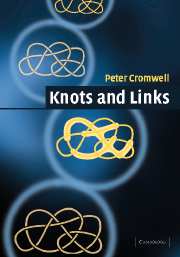Book contents
- Frontmatter
- Contents
- Preface
- Notation
- 1 Introduction
- 2 A Topologist's Toolkit
- 3 Link Diagrams
- 4 Constructions and Decompositions of Links
- 5 Spanning Surfaces and Genus
- 6 Matrix Invariants
- 7 The Alexander–Conway Polynomial
- 8 Rational Tangles
- 9 More Polynomials
- 10 Closed Braids and Arc Presentations
- Appendix A Knot Diagrams
- Appendix B Numerical Invariants
- Appendix C Properties
- Appendix D Polynomials
- Appendix E Polygon Coordinates
- Appendix F Family Properties
- Bibliography
- Index
Appendix B - Numerical Invariants
Published online by Cambridge University Press: 05 June 2012
- Frontmatter
- Contents
- Preface
- Notation
- 1 Introduction
- 2 A Topologist's Toolkit
- 3 Link Diagrams
- 4 Constructions and Decompositions of Links
- 5 Spanning Surfaces and Genus
- 6 Matrix Invariants
- 7 The Alexander–Conway Polynomial
- 8 Rational Tangles
- 9 More Polynomials
- 10 Closed Braids and Arc Presentations
- Appendix A Knot Diagrams
- Appendix B Numerical Invariants
- Appendix C Properties
- Appendix D Polynomials
- Appendix E Polygon Coordinates
- Appendix F Family Properties
- Bibliography
- Index
Summary
This table lists the numerical invariants discussed in the text.
Polygon indices are taken from. Richard Randell proved the minimality of the polygons with up to eight edges, so also did Seiya Negami; Jorge Calvo proved the 9-edge polygons to be minimal; the others are candidates for minimal polygons.
Genus is verified using the degree of the Alexander polynomial – see Theorem 7.2.1.
Determinant and signature are calculated as described in §6.6.
Unknotting numbers can be determined using the signature bound of Corollary 6.8.3 or from the fact that a value of 1 for a non-trivial knot must be minimal. The values marked have been determined using other methods. When the upper bound found by experiment and the lower bound obtained from theory do not agree both are given. Most of the values are taken from; several cases have been resolved since that table was compiled: 816 and 949, 917, and 810, 929 and 932.
Bridge numbers are either 1 (the trivial knot), 2 (for rational knots) or 3.
Braid indices are verified using the MFW inequality (see Corollary 10.3.3 and the subsequent discussion).
Information
- Type
- Chapter
- Information
- Knots and Links , pp. 294 - 296Publisher: Cambridge University PressPrint publication year: 2004
